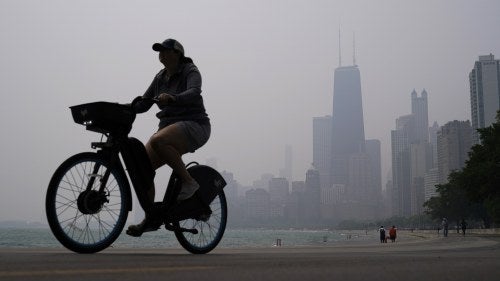From pollution to solutions: How global cities are tackling poor air quality

As Chicago and other global cities increasingly grapple with poor air quality, solutions to the problem vary by location.
When toxic smoke from Canadian wildfires began drifting across Chicago last summer, it highlighted a problem Chicagoans and others in major global cities have been facing for years: poor air quality. The Chicago metro area ranks among the worst in the U.S. for air pollution, according to the American Lung Association. Yet, the level of commitment toward solutions in the Windy City varies.
Since 2005, Chicago has been a member of C40, a network of global mayors taking action to curb climate change. The network has helped the city devise strategic local plans and partnerships to reduce air pollution. More recently, it launched another initiative aimed at intensively reducing pollutants across the world.
The Breathe Cities initiative, a project of C40, the Clean Air Fund, and Bloomberg Philanthropies, is investing $30 million across 11 global cities, many with longstanding ties to Chicago. Its aim is to spur each participating city to reduce its air pollution levels by 30% by 2030. Each location has agreed to design and apply measurable approaches toward reducing harsh pollutants — some ideas include shifting waste management policies, encouraging walking or cycling, and investing in sustainable public transportation.
“There is no ‘one size fits all’ solution,” said Sue Wixley, a spokesperson for the Clean Air Fund, which is helping fund Breathe Cities, in an email to ChicagoGlobal. “The feasibility and effectiveness of different actions will vary and they will need to be adapted to differing contexts and needs.”
Global cities find solutions
Paris, which is one of the Breathe Cities, plans to use collective research from the initiative to inform its local policy. Residents recently voted to increase parking fees for large SUVs in the city center and its surrounding arrondissements. The city will also launch a new “limited traffic zone” following the Olympic Games this summer.
Milan, another member of the initiative, plans to continue redesigning streets for pedestrians and cyclists. During the pandemic, the city announced its Strade Aperte (or Open Streets) initiative, through which it would widen sidewalks to limit space for cars, among other pedestrian-friendly changes. The city has also embraced low-emission zones as a solution in historically highly polluted areas.
This approach is similar to what is taking place in Warsaw, Poland which piloted Breathe Cities in 2022. The city is in the process of launching its first Clean Transport Zone project, requiring that vehicles meet certain exhaust emission standards to circulate in certain areas. Since the project’s announcement, a group of 35 businesses has called for the city to phase out diesel cars produced before 2014 by 2030.
In Ghana's capital of Accra, indoor air pollution has been a particular area of focus. To reduce the carbon emitted from cooking fumes, the city worked to distribute ceramic-lined cookstoves called gyapas to many households. The city, with air pollution 11 times higher than the World Health Organization’s recommended safe limit, is also experimenting with low-cost air sensors to collect data on air pollution across the Greater Accra Metropolitan Area.
Historically, many pollutant-reducing efforts have been supported through public-private partnerships, but some say the amount of public funding dedicated to these projects remains too small. According to the Clean Air Fund, clean-air projects accounted for just 1% (or about $2.5 billion) of international development funding and just 2% (about $1.66 billion) of international public climate finance from 2015 to 2021.
Chicago’s strategies for reducing pollutants
Though Chicago isn’t a member of Breathe Cities, the city does have a number of initiatives in the works for reducing pollutants at the local level. Strategies include improving transportation options and updating the energy code. The city council approved the Air Quality Ordinance in 2021 to regulate the construction and expansion of certain businesses that create air pollution, taking into consideration air quality before projects can move forward.

Haze from Canadian wildfires blankets the Chicago skyline as seen from the city's South Loop neighborhood.
Larry Ivory, who helped found the Illinois State Black Chamber of Commerce (ILBCC) in the 1990s and is now chairman of the National Black Chamber of Commerce, told ChicagoGlobal that public-private partnerships create jobs that help Chicago and other cities stay competitive. But efforts need to consider affordability, reliability, and health.
“African Americans are adversely impacted by air pollution and environmental issues because of high hypertension and asthma,” he said. “It directly impacts us in a way that is far more significant than you would normally see in other communities.”
The ILBCC is helping host an inaugural Clean Energy Summit this month, which will invite local businesses to discuss clean energy policies.
As summer approaches, the Illinois EPA plans to continue connecting with the public through virtual town halls and surveys. The agency adjusted its communication with the public last year to account for the toxic wildfire smoke by partnering with the Department of Public Health.
“We were receiving phone calls; people who hadn’t experienced smoke the way we had with the wildfires wanting to know what steps they needed to take,” said Kim Biggs, spokesperson for the agency, during an interview with ChicagoGlobal.
The agency will send air pollution alert messages with health advisements via text message, an app, email, and at National Weather Service stations throughout the state.
While tracking emissions usage and reduction is no simple task, local, national, and international interventions are useful approaches to identifying and refining long-term solutions in Chicago and elsewhere.
This story first appeared in the ChicagoGlobal newsletter, a joint project of Crain's Chicago Business and the Chicago Council on Global Affairs.

